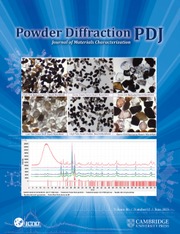I. INTRODUCTION
Perovskite manganites (RMnO3, R—rare-earth element) have attracted the scientific community for the past decade due to their unusual magnetic and electric properties (Abdel-Latif, Reference Abdel-Latif2012). Manganites exhibiting colossal magnetoresistance have gained attention due to their wide applications in the field of spin electronics (Srivastava et al., Reference Srivastava, Sandeep, Siwach, Amarjeet, Awana, Maurya and Singh2013). Among the various hole-doped rare-earth manganites, Sm1−x Sr x MnO3 (SSMO) is unique because this system exhibits colossal magnetoresistance (CMR) in a wide hole doping range from x = 0.3 to 0.52 with insulator metal transitions. For x = 0.3–0.52, the ground states are ferromagnetic metallic and become antiferromagnetic insulator for x > 0.52 (Srivastava et al., Reference Srivastava, Sandeep, Siwach, Amarjeet, Awana, Maurya and Singh2013). Damay et al. (Reference Damay, Nguyen, Maignana, Hervieu and Raveau1996) observed maximum CMR corresponding to x = 0.44 in the SSMO system, whereas Abramovich et al. (Reference Abramovich, Koroleva and Michurin2003) reported magnetic inhomogeneous ground state consisting of ferromagnetic, antiferromagnetic, and charge-ordering antiferromagnetic clusters for x = 0.4 and 0.45. Further Abramovich et al. (Reference Abramovich, Koroleva, Michurin, Gorbenko and Kaul2000) found 44% CMR accompanied by a magnetostriction of ~−10−4 under low magnetic field of 9.0 kOe in the Curie temperature region in Sm0.55Sr0.45MnO3. In general, compounds with ratio of Mn3+/Mn4+ > 1 are known to display ferromagnetic ground states (Abdelhadi and Ziq, Reference Abdelhadi and Ziq2013). By altering this ratio of manganese ions in manganites, magnetic properties can be changed. In view of this, it would be interesting to investigate the effect of iron substitution at Mn site where the ratio of the manganese ions changes. Hence, we have undertaken a systematic study of Sm0.55Sr0.45Mn1−x Fe x O3 and we report here the powder X-ray diffraction (PXRD) pattern of the pristine compound, Sm0.55Sr0.45MnO3 in this series of compounds Sm0.55Sr0.45Mn1−x Fe x O3.
II. EXPERIMENTAL
A. Synthesis
Polycrystalline Sm0.55Sr0.45MnO3 was prepared by solid-state reaction. Powders of Sm2O3, SrCO3, and Mn2O3 (4 N) were taken in stoichiometric ratios. The starting compounds were preheated at 700 °C to remove moisture. SSMO powders were obtained by mixing the starting compounds using a mortar and pestle. The prepared powder was heated to 1300 °C for 12 h in air with intermediate grinding.
B. Data collection
PXRDpatterns were recorded at room temperature using a STOE X-ray powder diffractometer operated in Bragg–Brentano geometry with fixed slits. CuK α radiation (1.5406 Å) operated at 40 kV and 30 mA was used to record the diffraction data. The 2θ scan range was from 20° to 90° with a step size of 0.05° and a count time of 25 s step−1. The powder was loaded in a zero background (911) Si single-crystal wafer holder.
III. RESULTS
The powder diffraction pattern (experimental) for the SSMO powder is shown in Figure 1. Rietveld refinement of powder diffraction pattern was performed using GSAS program (Larson and Von Dreele, Reference Larson and Von Dreele2000). Linear interpolation function was used to fit the background intensity (solid green line). Diffraction peaks were fitted using pseudo-Voigt function. Cell constants, R-factors and fractional coordinates of all the ions along with their occupancy corresponding to the final refinement are tabulated in Tables I and II, respectively. The solid blue colour line shown in Figure 1 is the calculated powder pattern. The difference between the calculated and experimental patterns is shown in solid black line. The expected Bragg diffraction peaks as per the space group (Pnma) which was used for refinement is shown at the bottom of the figure (vertical lines). Inset in Figure 1 shows the crystal structure of SSMO drawn by Vesta software (Momma and Izumi, Reference Momma and Izumi2013). The experimental peaks were indexed using PowderX software (Dong, Reference Dong1999); the cell parameters were refined with Pnma space group. Typical bond lengths and bond angles involving metal–oxygen are listed in Table III. The results of the peak indexing are given in Table IV.

Figure 1. (Color online) Rietveld refinement of X-ray diffraction data of Sm0.55Sr0.45MnO3 powder. Inset shows the SSMO structure and distorted MnO6 octahedra.
Table I. Refinement parameters of SSMO.

Table II. Fractional coordinates after the final refinement.

Table III. Selected bond lengths of SSMO.

Table IV. Powder diffraction data of SSMO.

IV. CONCLUSION
Structure refinement of SSMO was done which showed that the compound crystallizes in a distorted orthorhombic perovskite structure. The PXRD data that have been generated for this composition can be included into the PDF database as a new entry.
SUPPLEMENTARY MATERIALS
The supplementary material for this article can be found at http://dx.doi.org/10.1017/S0885715615000792
ACKNOWLEDGEMENTS
G. Murugesan would like to thank UGC-DAE CSR for the financial support and VIT University management for their constant encouragement.







